This chapter provides research-based guidelines for local data collection and analysis; school-level strategies; community-level strategies; and individual-level strategies. This is Chapter 2 of the IDRA Interrupting Bullying & Harassment in Schools Online Technical Assistance Toolkit.
Local Data Collection and Analysis: Interrupting Bullying & Harassment in Schools – Toolkit
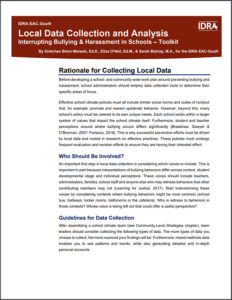 Before developing a school- and community-wide work plan around preventing bullying and harassment, school administrators should employ data collection tools to determine their specific areas of focus.
Before developing a school- and community-wide work plan around preventing bullying and harassment, school administrators should employ data collection tools to determine their specific areas of focus.
See PDF
School-Level Strategies: Interrupting Bullying & Harassment in Schools – Toolkit
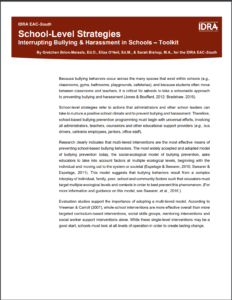 Because bullying behaviors occur across the many spaces that exist within schools (e.g., classrooms, gyms, bathrooms, playgrounds, cafeterias), and because students often move between classrooms and teachers, it is critical for schools to take a schoolwide approach to preventing bullying and harassment.
Because bullying behaviors occur across the many spaces that exist within schools (e.g., classrooms, gyms, bathrooms, playgrounds, cafeterias), and because students often move between classrooms and teachers, it is critical for schools to take a schoolwide approach to preventing bullying and harassment.
See PDF
Community-Level Strategies: Interrupting Bullying & Harassment in Schools – Toolkit
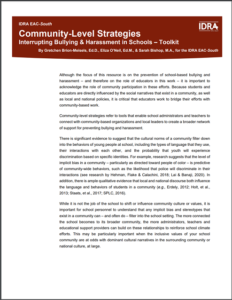 Although the focus of this resource is on the prevention of school-based bullying and harassment – and therefore on the role of educators in this work – it is important to acknowledge the role of community participation in these efforts. Because students and educators are directly influenced by the social narratives that exist in a community, as well as local and national policies, it is critical that educators work to bridge their efforts with community-based work.
Although the focus of this resource is on the prevention of school-based bullying and harassment – and therefore on the role of educators in this work – it is important to acknowledge the role of community participation in these efforts. Because students and educators are directly influenced by the social narratives that exist in a community, as well as local and national policies, it is critical that educators work to bridge their efforts with community-based work.
See PDF
Individual-Level Strategies: Interrupting Bullying & Harassment in Schools – Toolkit
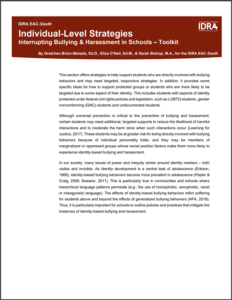 This section offers strategies to help support students who are directly involved with bullying behaviors and may need targeted, responsive strategies. In addition, it provides some specific ideas for how to support protected groups or students who are more likely to be targeted due to some aspect of their identity. This includes students with aspects of identity protected under federal civil rights policies and legislation, such as LGBTQ students, gender nonconforming students and undocumented students.
This section offers strategies to help support students who are directly involved with bullying behaviors and may need targeted, responsive strategies. In addition, it provides some specific ideas for how to support protected groups or students who are more likely to be targeted due to some aspect of their identity. This includes students with aspects of identity protected under federal civil rights policies and legislation, such as LGBTQ students, gender nonconforming students and undocumented students.
See PDF
Principal Checklist to Reduce Bullying and Harassment – Supporting Safety and Learning for All
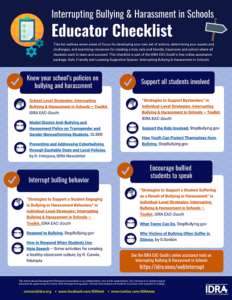 Developing a safe and healthy school climate requires taking steps to prevent bullying and harassment in the school community. Principals should focus on connected, coordinated efforts and programs to train staff and engage students in communities for bullying prevention. Anti-bullying policies should help normalize safety and positive communication and describe the consequences of negative behavior and actions.
Developing a safe and healthy school climate requires taking steps to prevent bullying and harassment in the school community. Principals should focus on connected, coordinated efforts and programs to train staff and engage students in communities for bullying prevention. Anti-bullying policies should help normalize safety and positive communication and describe the consequences of negative behavior and actions.
Additionally, school administrators should actively listen to and support students who have been targeted by bullying and harassment, signal that negative judgments and stigmatizing will not be supported or approved, accept the traditions and methods of expression of their students’ religions and cultures, and create a learning environment that acknowledges and supports the assets each individual student brings and actively support cross-cultural acceptance and understanding.
See article
3 Ways to Make Schools Safe for LGBTQ Students
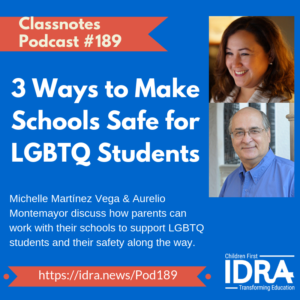 LGBTQ (lesbian, gay, bisexual, transgender, and queer or questioning) students face particular challenges in our classrooms 85% report facing verbal harassment, more than one in four are physically harassed at school, and half are threatened by their classmates.
LGBTQ (lesbian, gay, bisexual, transgender, and queer or questioning) students face particular challenges in our classrooms 85% report facing verbal harassment, more than one in four are physically harassed at school, and half are threatened by their classmates.
Michelle Martínez Vega, IDRA technology coordinator, and Aurelio M. Montemayor, M.Ed., director of IDRA’s Texas Education CAFE Network project funded by the W.K. Kellogg Foundation, discuss how parents can work with their schools to support LGBTQ students and their safety along the way.
Listen to podcast episode 189
Making Schools Safe Learning Havens for LGBTQ Students
LGBQT students face attacks and discrimination daily in schools – from outward aggression to implicit bias that makes their campus feel unwelcoming. In the United States, 60% of students feel unsafe at school because of their sexual orientation.
All students have the right to be safe in school and to have the support of educators to help them learn. Educators can create an anti-bias and safe learning environment through focused and strategic planning, professional development and adopting specific strategies. This article outlines four key areas for focus: reframing communication, analyzing school policies, confronting myths and stereotypes, and preventing and eliminating harassment and violence.
See article
Religion Equity in Schools – Protecting Students and Their Civil Rights
Recently, there has been a rise in the number of Muslim and Sikh students who face bullying and harassment at school due to their religious affiliation or expression. In this article, Paula N. Johnson focuses on religious diversity as a protected civil right, how schools can foster more inclusive learning environments, and recommendations for educators.
Many times, students can be targeted because of visible symbols they wear in accordance with their religious beliefs. To alleviate these issues and protect all students, we must work to prepare teachers and help students appreciate, respect, understand and learn from students of other cultures.
See article
Relational Youth Violence – Protecting Muslim Youth in School
School-age children in the United States are growing up in an environment that is increasingly hostile toward the Muslim community. Analyzing the most recent FBI data available, the Pew Research Center (2016) finds that hate crimes against Muslims in 2015 had risen to similar levels as those committed shortly after 9/11, which was a 67 percent increase in incidents from the previous year. Although 2016 numbers from the FBI will not be available until late this year, it is unlikely that this number will have decreased.
The Southern Poverty Law Center (2016) has been gathering unofficial counts of hateful harassment and intimidation. In the five days after the 2016 election, it documented more than 40 anti-Muslim incidents. Furthermore, of the total 437 total incidents collected, 99 (23 percent) occurred in a K-12 setting; this was the most frequently-cited location for harassment incidents.


